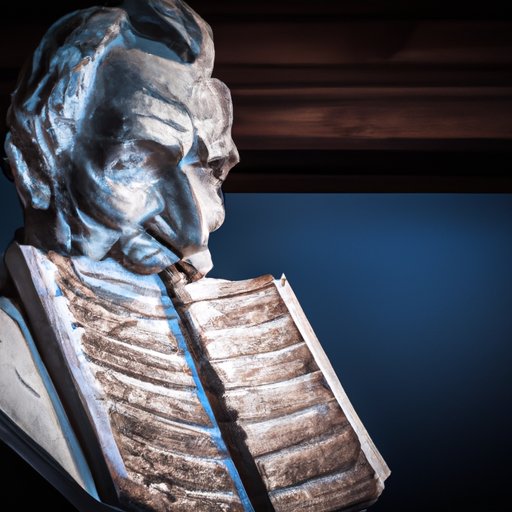I. Introduction
The Renaissance is considered one of the most significant periods in human history, representing a cultural and intellectual revival that forever changed the course of Western civilization. From art and science to religion and politics, the Renaissance was a catalyst for a revolution that reshaped our understanding of the world. In this article, we will explore the factors that led to the Renaissance, and how it emerged as a defining moment in human history.
II. The Spark that Ignited the Renaissance: Historical factors that contributed to its emergence
The Renaissance was not an isolated event, but rather the product of a complex interplay of historical, economic, and social forces shaping Europe during the late Middle Ages. One of the most significant factors that paved the way for the Renaissance was the decline of feudalism and the rise of city-states, such as Florence and Venice, which became thriving centers of trade and commerce.
The Crusades, which began in the late 11th century, were a critical catalyst, stimulating trade and cultural exchange between Europe and the Islamic world. The Black Death of the mid-14th century killed one-third of the European population, forcing a fundamental reassessment of society and leading to new philosophies about the meaning of life and death.
The fall of Constantinople in 1453 was a final blow to the Byzantine Empire and resulted in the exile of many scholars, who brought with them the knowledge of ancient Greek and Roman texts. These works, which had been lost to Europe for many centuries, were eagerly studied by humanist scholars and became one of the pedagogies that formed the core of Renaissance culture.
III. From Darkness to Light: Exploring the Intellectual Revival that Launched the Renaissance
The Renaissance was, first and foremost, an intellectual movement. The revival of classical texts and ideas, including humanist philosophy and rhetoric, energized a new generation of scholars who sought to forge a new path for European civilization. Likewise, the rise of universities and education fostered intellectual curiosity and creativity, particularly in the fields of mathematics, physics, and astronomy.
The impact of the printing press cannot be overstated, allowing for the dissemination of knowledge and ideas on an unprecedented scale. The invention of movable type printing by Johannes Gutenberg in 1440 made it possible to mass-produce books, reducing their cost and increasing access to knowledge.
IV. A New Era of Cultural Excellence: How Art, Science, and Religion Combined to Create the Renaissance
The Renaissance was a cultural watershed, marking the emergence of new artistic techniques, styles, and mediums. The term “Renaissance” itself means “rebirth,” and the painters, sculptors, and architects of the time celebrated a return to the ideas of classical antiquity.
The Renaissance also saw significant advancements in science, including the study of astronomy and anatomy. The works of scientists like Galileo Galilei and Leonardo da Vinci heralded a new age of understanding and experimentation, inspiring generations of thinkers and inventors.
Religion played a critical role in Renaissance culture. While the ideas of the Church had dominated medieval thought, the Renaissance saw the emergence of a more secular worldview. Artists like Michelangelo and Raphael continued to include religious themes in their work, but with a more humanistic and individualistic approach, celebrating the beauty of humanity as well as the divine.
V. Breaking Free from the Middle Ages: The Economic, Political and Social Changes that led to the Start of the Renaissance
The Renaissance was shaped by significant economic, political, and social changes, which allowed it to take root and flourish. The rise of the merchant class, for instance, challenged the old feudal order, as money and commerce replaced land and tradition as the key to power and influence.
New political systems such as republics and monarchies emerged, which shifted power away from the old nobility and towards a new class of educated professionals. Meanwhile, social changes, including the rise of individualism and secularism, led to a reassessment of what it meant to be human, and what role humans should play in shaping their destiny.
VI. Uncovering the Roots of Renaissance Italy: Analyzing the Impact of Humanism, Patronage, and Global Influences
The Renaissance was most prominent in Italy, where it began in the fourteenth century. Italian cities such as Florence, Rome, and Venice became centers of art, literature, and secular learning. Humanist ideas – which emphasized individualism, human dignity, and the pursuit of knowledge – were especially influential in Italy at the time.
The support of wealthy patrons also played a crucial role in the development of Renaissance culture. Powerful families like the Medici and the Sforza’s used their wealth and influence to support artists, writers, and scientists, creating an environment that fostered innovation and creativity.
Italy’s global connections also played a role in the Renaissance, with Italian merchants trading with merchants in the Islamic world, India, and China. This trade facilitated cultural exchange and the spread of Renaissance ideas beyond Italy’s borders.
VII. Conclusion
The Renaissance was not a single event but rather a complex interplay of historical, intellectual, and cultural factors. It represented a new era of human knowledge and creativity, challenging long-held assumptions and creating a more secular and individualistic world. The legacy of the Renaissance continues to shape our world today, from the way we think and learn, to the way we view art and culture.
If you want to explore more about the Renaissance and its impact, we encourage you to continue learning and discovering. Read literature, visit art galleries, and museums, and engage in discussions with experts in different fields. You never know where the next spark of inspiration might come from.
